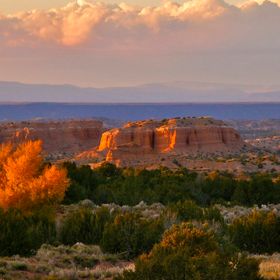Throughout the year the 13,000-ft Truchas Peaks frequently burst into color right before Sunset.
Throughout the year the 13,000-ft Truchas Peaks frequently burst into color right before Sunset.
Read less
Read less
Views
216
Likes
Awards
Action Award
Zenith Award
Community Choice Award
Top Ranks
Same photographer See allBehind The Lens
Behind The Lens
Location
Those are the Truchas Peaks in the Sangre de Cristo mountains, Located in Truchas, (northern) New Mexico. The "Sangres," as we call them, are at the southern end of the Rocky Mountain chain. The peak on the right is the highest at 13,109 ft. To its left is Middle Truchas Peak at 13,096 ft. Left of center, in the shadow of a cloud, is North Truchas Peak, at a little under 13,000 ft. Just to the West of the peaks, at 8,100 ft, lies the small Spanish Land Grant village of Truchas. Located about half-way between Santa Fe and Taos, Truchas was a destination for many hippies including Janis Joplin, Jimi Hendriks, Lisa Law (photographer), etc. In the late 1980s Robert Redford directed his first movie, "Milagro Beanfield War. To capture this image, I had to step out our front door (after putting on a warm jacket--it was New Year's Day 2006) and shoot. You might guess that I have many many images of the peaks in all the seasons, both day and night. lisaTime
Just before 5:00 P.M. MST I looked out and there it was--just another New Mexico sunset, ho hum! By the way, with sunsets on the mountain you need to be quick. The peaks will become dull grey shortly after they became bright.Lighting
More than likely I spot metered the bright snow or the cloud just above the peak and over exposed by 1/3 or 2/3. If the sky to the North had been clear I might have taken a spot reading at 45° elevation (considered that to represent Zone V), and used that as my exposure.Equipment
The camera was a Canon EOS5D with a Canon 28-135 mm IS lens, handheld. Settings: ISO 200, f/5.6, 1/160 sec.Inspiration
My inspiration is just where I live. The peaks are very much "there" all the time. Sunset views to the West are equally captivating. My files are full of similar images. Likewise, night skies--Milky Way, etc---demand to be photographed.Editing
I used Photoshop CS2 but that was back in 2006 so who could remember?In my camera bag
All Canon bodies and lenses, plus several Tamron lenses plus 1.4 and 2X tele-converters, some filters, etc.Feedback
1. Know your equipment. 2. Know your environment--anticipate clues as to what might happen, e.g., might the gray clouds start to get a bit pink, signaling the onset of a great Sunset. 3. While you are working with the scene in front of you, don't forget to turn around. You might be amazed at the scene behind you (and no, I don't mean a Grizzly sneaking up behind you!).



























